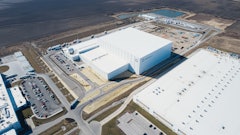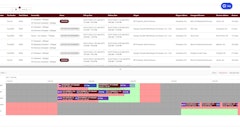For years, it was believed that most mobile electronic devices simply could not work for long periods of time in cold storage environments. More and more product testing by the manufacturers of these products is now painting a different picture.
"Cold has always been a problem, but it's not so much the cold by itself as it is going from the cold to other environments, like a loading dock in the middle of July in Houston," says Brian Viscount, vice president of marketing for rugged handheld devices at Symbol Technologies, Holtsville, NY. "A device stored in a freezer and only used in a freezer will never see condensation."
Condensation, he says, and not the cold itself, is the real enemy of most handheld electronics used in the warehouse. Particularly in warehouses where workers move between humid shipping docks, refrigerated zones and sub-zero freezers, these temperature changes cause condensation and other conditions that can wreak havoc on mobile warehouse equipment. Frozen keypads, fogged screens, display failures and corrosion of internal parts are usually the end result, leading to lost productivity and higher maintenance and operating costs.
"Operating in the cold is one thing; preventing condensation is another altogether," Viscount continues. "Once you get humidity inside a device, it's a problem, but if you manage your devices properly, you will not see condensation."
When buying any handheld devices, the first and foremost consideration should be the IP (short for ingress protection) rating. The IP rating scale, put forward by the International Electrotechnical Commission (IEC), involves two numbers. The first number (from one to six) represents a device's ability to withstand dust; the second (from one to eight) represents the ability to withstand water. The higher the IP rating, the greater a device's resistance to dust and moisture. Many products made for warehouse applications, especially those with freezer or multi-temperature zones, now have IP ratings of 64 or better.
Check The Drop Rating
The next thing to consider is the product's drop rating, which refers to the number of feet from which a device can fall to concrete without suffering damage or malfunctioning.
Added importance is given to drop ratings for devices to be used in cold storage environments because the plastics used to make the devices can become brittle-and therefore more susceptible to cracks or breaking-when temperatures drop below freezing. Where products crack, chip or warp, moisture can get in and then cause condensation when going back and forth between cold and ambient zones within a warehouse.
Don't just buy the first model that you come across either, warn manufacturers. "Warehouses want and need their computer technology to work every day, all day. You could buy on the cheap and just replace [equipment] when it breaks, but now you have downtime where a guy can't work," warns Doug Brown, senior manager of mobile computing products at LXE, Norcross, GA.
Once you settle on a device, there are a number of other things that you can do to make sure that the device continues to operate at peak performance. Symbol's Viscount suggests using a heated "boot" on a forklift and placing handheld devices inside the boot for a few minutes immediately after taking them outside the freezer. This, he says, will cut down on the condensation much the same way that defrosters work on car windshields.
To prevent damage that will allow moisture and condensation to get inside devices, it is especially important to keep track of how employees are using them throughout the day. "Some workers may try to break them as an excuse not to work as hard," Brown says. "It's a very common thing for products to come back damaged intentionally by workers."
"We find out a lot about what people are doing with our products," adds John Murphy, manager of product development at Zebra Technologies, Vernon Hills, IL. "When we get things back, we often find the keypads are broken because people are operating them with a pen instead of their fingers. They're dropping and dragging the product, and occasionally, one gets run over by a forklift."
Though there's little a manufacturer can do to make its products resistant to that kind of damage, handheld product manufacturers are taking steps to make their products more resistant to normal wear and tear and subsequent condensation damage that can result.
Testing Is Key
"There are real-life problems that people in warehouses have to address, and they expect companies like LXE to handle them," says Brown. To that end, manufacturers like LXE have begun subjecting their equipment to the toughest testing ever. Many have now begun to release-or re-release-fully reengineered devices proven to operate at peak performance even in the coldest of environments.
Psion Teklogix, based in Mississauga, Ontario, Canada, for example, subjects its mobile computers to independent laboratory testing that includes soak tests, cyclical temperature changes ranging from 122 degrees to an icy 22 degrees below zero, as well as rigorous shock and vibration testing.
At Zebra Technologies, testing of its mobile handheld printers includes "harsh environments by way of temperature and exterior elements," says Murphy. "We've specifically made adaptations to the products for freezer environments."
In the past, a big problem with most units had been that they were not airtight, allowing condensation to form on critical components. Today, manufacturers have begun using conformal coating, "a plastic spray that seals all the pins and other components on the motherboards so that even if water gets in, it does not cause damage," Brown explains.
Also big on the list of priorities for manufactures has been the use of more industrial-grade plastics and harder metals, like magnesium, to better absorb shocks. Many have also added thicker housing and rubber bumpers to the outsides of their products as well.
"It's amazing how much banging around a product sees in a day," says Symbol's Viscount. "We have greatly enhanced our products to absorb shocks in the distribution center to minimize failures that occur from drops."
Battery power drain is another concern when it comes to cold storage environments, and manufacturers are responding with longer-life batteries. When batteries do fail, though, many also now feature new data storage methods to protect or back up the data they contain.
Intermec Technologies Corp., Everett, WA, for example, has added what it calls "persistent storage," an onboard, non-volatile memory system which preserves applications and databases even if the battery becomes depleted. Optional removable storage card slots provide even more memory if desired.
"Mobile workers require devices that won't quit on them, no matter what the working conditions," says Mike Colwell, Intermec's vice president. They also need to be kept "productive for their entire shift while protecting the valuable data they collect."
The constant need for testing is a big switch for the manufacturers, who first focused more on functionality rather than ruggedness.
Before Systems Applications Engin-eering (SAE), a hardware and software systems integrator based in Houston, could recommend Symbol's handheld products to clients like Sysco Foodservice, it had to do a lot of testing as well. "We did a significant amount of testing at customer sites. We put them in freezers, brought them out, and them put them back in again," says Bill Elliott, vice president of sales and marketing.
The results, he said, were better than expectations.



























